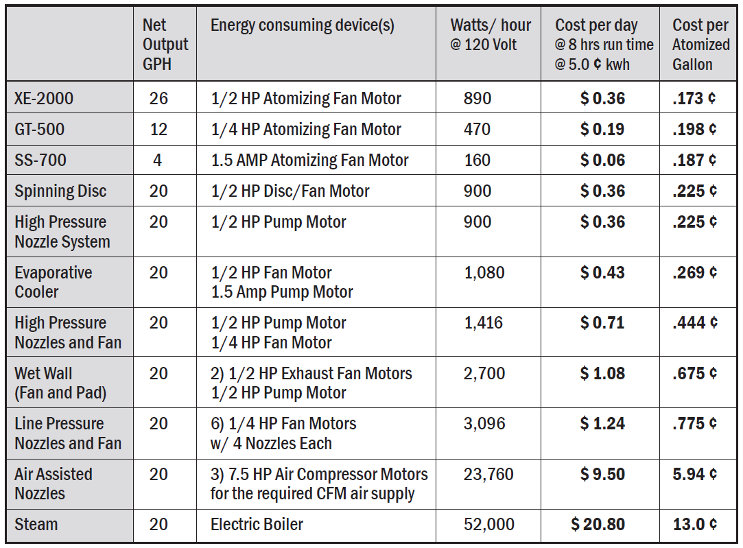Need to Know FAQs
Hydro SS
Need to Know FAQs
- What is the difference? "Direct-feed" vs "Hanging Sump"
Direct-feed - Utilizes standard water pressure to feed water to the atomizing fan.
Pros - Fewer components; increased relilability, lower unit cost, a visual scale; needle valve flow control.
Cons - Requires drainage area for waste water control.
Hanging Sump - Uses a sump pump to feed water to the atomizing fan.
Pros - Recycles and conserves water, no drainage line.
Cons - Added unit cost and components, a quarter-turn ball valve replaces the visual scale; needle valve flow control.
- How energy efficient are the Hydros?
Energy Consumption Comparison

- What is the fog particle size and will floors get wet?
The particle size produced by the Hydro SS averages 50 microns in size, with the probability of wetness below and near the unit. Particles measuring smaller than 50 microns will usually evaporate before hitting the floor. Mother nature’s fog averages 5 to 10 microns in size.
Suspending units up high and where no sensitive equipment is directly underneath is recommended. Maintaining drier floors can be enhanced by using an additional air moving fan to help evaporate the mist particles. Placing a fan directly underneath and aimed upward to blast air into the fog pattern will greatly increase and force evaporation, when necessary.
- What are the pros and cons of the DF, BT, HS models?
Direct Feed
Pros
- Lower original equipment costs
- Fewer parts and greater dependability
- Mountable up high allows for better performance
- Greater selection of accessories
Cons
- Nearby drainage required
Bench Top
Pros
- Highly mobile
- No nearby drainage necessary
- Reuses its own waste water
- On/OFF power switch
Cons
- Greater original equipment costs
Hanging Sump
Pros
- Highly mobile
- Mountable up high allows for better performance
- No nearby drainage necessary
- Reuses its own waste water
- On/OFF power switch
Cons
- Greater original equipment costs
- Where should the Hydro SS be installed for best results?
The optimal placement of the Hydro SS is high, overhead and oriented to propel fog in the direction of air flow.
The Bench Top should be placed at bench height or higher on a shelf. For the Direct Feed and Hanging Sump units, look for large, open areas up high. Allow adequate clearance directly in front of the fans, or objects that are too close could become wet and result in dripping. A Hydro SS aimed to propel fog horizontally will produce a downward arc in its fog pattern. Placing units higher allows more time for particles to evaporate as they fall, keeping floors drier.
- Should I use a humidistat control?
Humidistat controls work best for applications requiring 80% RH or less. If you need to maintain RH above 85%, do not consider using a mechanical humidistat control.
If you are interested in evaporative cooling and have thermostatically controlled exhaust fans, using a humidistat control is a great choice. The two independent systems will work very well together, for cooling as well as for providing a maximum set point for relative humidity control.